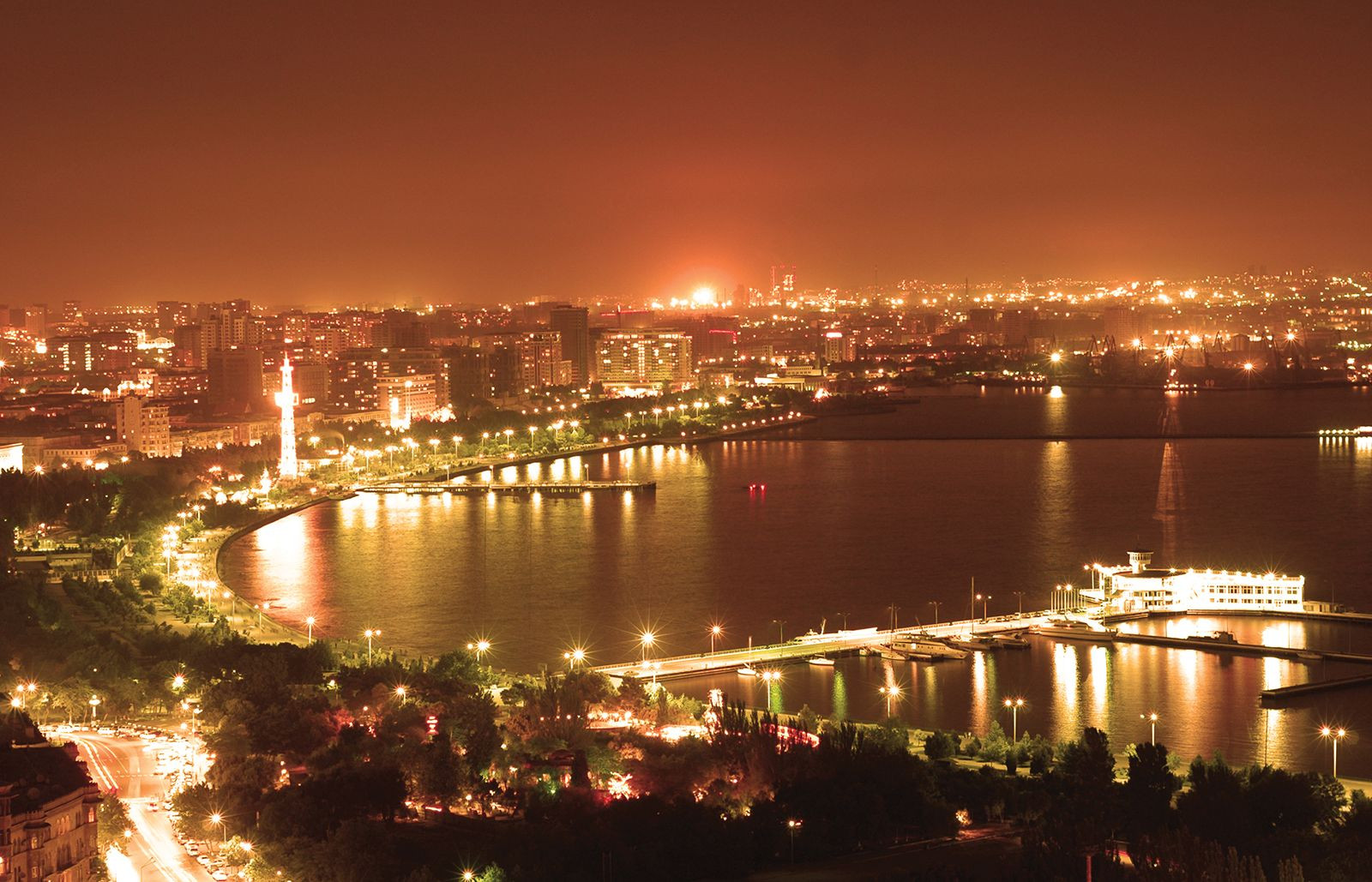Baku, a city that seamlessly blends ancient history with modern dynamism, stands as the vibrant capital of Azerbaijan. But where is Baku, Azerbaijan located exactly? This captivating metropolis graces the western coast of the Caspian Sea, a strategic position that has shaped its rich past and continues to fuel its thriving present. Nestled on the southern edge of the Absheron Peninsula, Baku curves gracefully around the Bay of Baku, a naturally sheltered harbor that has been pivotal to its development for centuries.
The geographical setting of Baku is truly unique. The Bay of Baku, shielded by the Baku Archipelago islands, offers the Caspian Sea’s most ideal harbor, historically making it a crucial maritime hub. Furthermore, the Absheron Peninsula itself acts as a natural barrier, protecting the city from harsh northerly winds. The very name “Baku” is thought to originate from the Persian phrase “bad kube,” meaning “blown upon by mountain winds,” a testament to the region’s distinctive climate and geography. This strategic location, combining natural harbor and defensible peninsula, has contributed significantly to Baku’s historical and economic prominence, particularly in the oil industry and its role as an administrative center.
 Night view of Baku, Azerbaijan
Night view of Baku, Azerbaijan
Delving into Baku’s history reveals how its location has been intrinsically linked to its identity. While historical records first mention Baku in 885 CE, archaeological discoveries suggest a settlement existed here long before Christ. By the 11th century, Baku had become a significant city under the Shirvanshahs, who elevated it to their capital in the 12th century. Throughout the 13th and 14th centuries, Baku experienced periods under Mongol rule, highlighting its position as a point of interest for empires seeking control in the region. In the early 18th century, Peter the Great of Russia briefly captured Baku, recognizing its strategic value, but it was later returned to Persia. Russia finally secured Baku in 1806, further embedding it within the geopolitical landscape of the time. The 20th century marked a turning point when Baku became the capital of the Azerbaijan Republic in 1920, solidifying its status as the nation’s heart.
Today, Baku’s geographical core remains the ancient walled city, Icheri-Shekher, a UNESCO World Heritage site. This “Inner City” showcases Baku’s historical depth, with fortified walls largely intact since their strengthening after the Russian conquest in 1806. Iconic landmarks like the 90-foot Maiden’s Tower (Kyz-Kalasy) from the 12th century and the Palace of the Shirvanshahs, with parts dating back to the 11th century, stand as testaments to Baku’s enduring heritage. The labyrinthine alleys and ancient structures within Icheri-Shekher paint a vivid picture of Baku’s past. Beyond these historic walls, modern Baku has expanded, creating a captivating contrast between the old and the new. Imposing modern buildings and regular streets now ascend the hills surrounding Baku Bay, showcasing the city’s growth and ambition.
Baku’s location is not only historically significant but also economically vital. The city’s economy is fundamentally built upon petroleum. The presence of oil has been recognized since ancient times, with rudimentary surface wells operating as early as the 15th century. Modern commercial oil exploitation began in 1872, transforming Baku into a global oil powerhouse. By the dawn of the 20th century, Baku’s oil field reigned as the world’s largest, and it remained the largest within the Soviet Union until the 1940s. Even as easily accessible reserves diminished, Baku continued to innovate, extending drilling operations deeper underground and further into the Caspian seabed. Post-independence Azerbaijan has welcomed international collaborations to explore and develop new oil sites, establishing modern refineries and maintaining Baku’s central role in the energy sector. The iconic sight of oil derricks in the Caspian Sea near Baku serves as a constant reminder of this industry’s profound impact on the city.
 oil derricks near Baku
oil derricks near Baku
Beyond its industrial prowess, Baku’s location has also fostered its development as a major cultural and educational hub. The city is home to Baku State University, established in 1919, and numerous other higher education institutions specializing in diverse fields, including the oil industry. The Azerbaijan Academy of Sciences and numerous museums, including the State Art Museum, contribute to Baku’s intellectual and artistic landscape. Modern architectural marvels like the Heydar Aliyev Centre, designed by Zaha Hadid, further enhance Baku’s cultural appeal, demonstrating its embrace of contemporary design while respecting its historical roots.
In conclusion, Baku, Azerbaijan is located on the western coast of the Caspian Sea, on the southern Absheron Peninsula, surrounding the Bay of Baku. This geographically strategic position has been instrumental in shaping Baku’s history, economy, and cultural identity. From its ancient origins as a sheltered harbor to its modern status as an oil-rich capital and a vibrant cultural center, Baku stands as a testament to the enduring influence of location on a city’s destiny, truly earning its title as the “Pearl of the Caspian Sea”.
